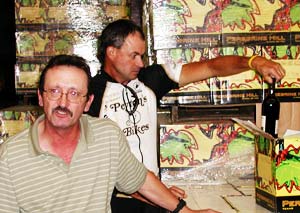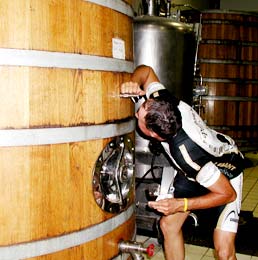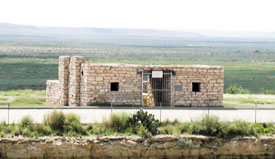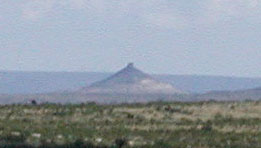MLB and I recently traveled 110 miles southwest to Fort Stockton, where the annual HarvestFest celebration was taking place. The attraction of this event to us came in the form of a bike ride to the Cordier Estates winery located 26 miles east of town, pretty much in the middle of nowhere.
This sounded interesting for several reasons. First, we’d never ridden much east of town and the landscape warrants closer scrutiny than that provided through a car window on the interstate. Second, we’d never toured the winery…and the facility is now closed to the general public except for special occasions like this. And, finally, after weeks of rainy and/or stormy weather, the forecast was for sunny and calm conditions, and our tandem was begging for a workout. We hadn’t ridden much at all lately, but a 52 mile ride didn’t seem like overreaching, especially with a nice break at the turnaround.
Saturday dawned clear and cool, as forecast. With temps in the upper 50s, my sleeveless jersey and shorts didn’t immediately seem like the wisest choice of apparel, although I was counting on a quick warmup in the bright sunshine. Our plan was to drive to Rooney Park to register at 8:30, return to my parents’ house to complete our preparations, then ride back to the park in time for the ride start at 9:30. It was a good plan, but we didn’t count on the fact that we were the only ones that had a plan, period.
At 8:30, there was no one at the registration area. At 8:45, someone showed up, only to say that the ride coordinator was participating in the 5K fun run and nothing would happen until he finished the race.
Being the adaptible folks we are, and understanding how things work in small towns, we decided to return home, gear up and ride back to the park to register…which we did. Unfortunately, by 9:15, the ride coordinator had shown up but had no forms. (He said that he’d only agreed to be the coordinator because the event organizers had promised him that he wouldn’t have to do anything.)
He set off on his bike in search of registration forms, but several impatient riders (mostly from the Midland-Odessa area) decided to begin the ride immediately. By the time the guy returned, forms in hand, only a few of us were still around to take care of the formalities (which included paying $15 per person to cover the sag stop provisions, winery tour and tasting and — what else? — t-shirt). We ended up departing around 9:45, which is considered fashionably late in many circles.
The ride to the winery was, in a word, wonderful. Surprisingly, our destination was at a lower elevation than our start…in layman’s terms, the ride out was downhill (although there were three relatively steep hills on the route). We also had a slight breeze at our backs. The result of these conditions was that our riding time for the 26.4 miles was almost exactly 90 minutes. That 17.6 mph average was much better than our normal pace, and I suspect most of the single bike riders averaged close to 20 mph. Of course, you are perceptive enough to realize that on an out-and-back course, ideal conditions going one way don’t really bode too well for going the other. More about that later.

A wonderful vista…we’re riding toward the morning mist.
The scenery was beautiful, in the rugged and sparse fashion of the desert…a desert that had enjoyed significantly higher than usual rainfall during the previous six months. The overall hue of the landscape was green, instead of the more usual beige and brown, and the I-10 service road was lined with thick grasses and wildflowers. We spotted numerous tiny ponds where a month ago, there was nothing but bare rock. Standing water in west Texas pastures are scenes to be treasured.

A micro-oasis…and a rare sight in this area
The winery tour was fascinating. Our guide was the executive manager, a Frenchman named Michel, who didn’t seem at all annoyed to be confronted on a Saturday afternoon with more than a dozen sweaty bicyclists with funny accents. He gave us a thorough tour of the operation, beginning with the bin where the grapes were dumped immediately after the harvest, to the warehouse filled with cases of finished product awaiting shipment.

Winery manager Michel talks about the new
premium wine label, Peregrine Hill.
The stats are amazing. With about 800 acres of producing vineyard (out of about 1200 potential acres), the harvest this year was about 3,200 tons. The winery has a capacity of 1.6 million gallons per year, but they have the grapes for only about 600 thousand gallons. Therefore, they bottle wine on a contract basis as well. This year, they have produced wine for French and Australian labels, as well as their own St. Genevieve and Peregrine Hill labels (the latter is a new premium label for the winery).
We ended the winery tour at a table containing six or eight bottles of wine and large fruit and cheese platters. Ordinarily, this wouldn’t be considered to be the ideal mid-ride restorative repast, but we didn’t really have a choice. MLB and I don’t normally drink wine, but we were curious about the end result of the process about which we’d just been educated. Besides, we didn’t want to offend our hosts (the chief winemaker herself had joined us halfway through the tour) who were so proud of and enthusiastic about their work.

Lance, one of the riders from Odessa,
is a serious oenophile.
We tasted four varieties: a Chiraz, a Chardonnay, a Merlot and a Blush. Not being oenophiles, we weren’t impressed one way or another, but the Merlot seemed to get the best reactions from the other riders, most of whom were enthusiastically draining their sample glasses and holding them out for refills. (Oh, did I neglect to mention that a trailer was available for cyclists who didn’t feel up to the ride back to town…for whatever reason?)
About an hour after arriving at the winery, MLB and I excused ourselves from the rest of the group and headed back into town. We stopped several times to take photos, and had a nice visit with the elderly lady who provided a rest stop just down the hill from the old stagecoach stop, about eight miles from the winery. I have to admit that her Gatorade, bananas and Snickers were really a welcome improvement over the winery fare.

This was a stagecoach stop in the 19th century;
it’s now a rest area on I-10
The trip back to town was harder — uphill and into the wind are not our favorite cycling conditions — but not agonizingly so. We weren’t in a hurry, and the weather and scenery were good enough to keep us in a decent frame of mind. Still, we were famished when we got back to the starting point, where hundreds of folks were now milling around the park, enjoying live music, fair food, a car show and the typical festival attractions for kids. Most of the food vendors were local families, and the offerings were uniformly tantalizing: asado burritos, brisket sandwiches, tamales and so on. In short time, we were gastronomically recharged and ready to call it a day.
We were a bit of a spectacle riding out of the park, as the only route out went in front of the music stage, but after six years of riding the longest production tandem in the world*, we’re used to it. I figure most people thought we were just part of the carnival atmosphere.
Overall, it was a very enjoyable day and we’re glad we did the ride. I think we’ll seriously consider doing it again next year.
But we never did get our t-shirts!

This is a famous area landmark, recognized and remarked upon by
every 14-year old male ever to live in Pecos County.
*It’s weird to join a group of people, none of whom you’ve ever met, and find out that you’ve been a topic of discussion. That was the case on Saturday, when we discovered that among the Permian Basin cycling community, our bike is known as “the SS Siegmund.”
Discover more from The Fire Ant Gazette
Subscribe to get the latest posts sent to your email.
